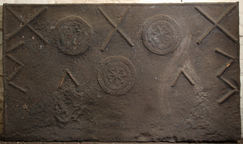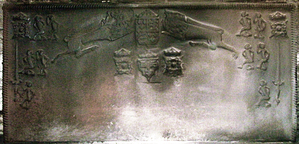-
1042
Description: Rectangular; twisted rope edging (top and sides); top centre, twisted rope saltire between two food moulds used as stamps, comprising two concentric discs with a hatched design and enclosing four hearts arranged in a cross; below the saltire another food mould stamp; in the top corners, a twisted rope saltire with a double V design below each, the open ends facing inwards; below each of the upper pair of food mould stamps, an inverted twisted rope V.
Notes: The food mould stamps can be seen on another fireback dated to 1562; the rope Vs and saltires have an apotropaic, or evil averting, purpose.
- Decoration tags:
- rectangular (shape)
- rope (edging)
- simple stamps
- carved stamps
- apotropaic
- objects
Manufactured: in the mid-16th century in the Weald area of England.
Current location: Manor House, North Lane, West Hoathly, West Sussex, England.
Citation: Hughes, G. B., May 1940, 'Old English Firebacks', Apollo, 31, 185, pp. 117-120.
- Attached to series:
- Food mould stamp firebacks
- Heart cross stamp series
-
595
Description: Rectangular; twisted rope edging (top and sides); top centre; crowned Tudor royal shield with angled lion passant guardant sinister to the left, and an angled lion passant to the right; below, a crowned shield with a fleur-de-lys below initials (over-pressed), between two four-petalled, crowned roses; the same crowned rose repeated in each top corner, below each a vertical dagger, point upwards; inside the roses and daggers, two tiered pairs of ‘imp’ figures, one of each with arm raised, above a single figure, its arms lowered.
Notes: Each dagger, which is seen on two other firebacks (no. 660 and no. 1100), is approx. 35cm long.
Copies of this fireback are known.
Inscription: KH
Arms: Tudor royal arms of England
- Decoration tags:
- rectangular (shape)
- rope (edging)
- carved stamps
- heraldic
- armorial
- royal
- animals
- humans
Manufactured: in the mid-16th century in the Weald area of England.
Current location: in private hands, Wigmore, Herefordshire, England.
- Attached to series:
- Royal series
- Knife & Dagger stamp firebacks

